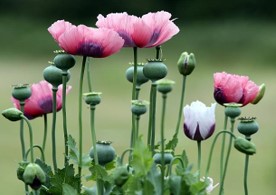Role of Ahiphena (Papaver sominiferum) in modern and ancient treatment
DOI:
https://doi.org/10.21760/jaims.8.10.25Keywords:
Ahiphene, Codeine, MorphineAbstract
Opium is botanically known as Papaver someniferum is cultivated in eastern countries and India only under license. Ahiphena cultivation is illegal in many countries due to its narcotic action. It is the source of various pharmaceutical alkaloids including morphine, codein etc. Ahiphena is not mentioned in Brihattrayee texts. Sharangdhara mentioned Ahiphena under Vyavaya Dravya in Raj Nighantu. Ahiphena comes under the class of Upavisha and it is used in various Kalpanas. Morphine is an analgesic opioid and is one of the most potent pain relievers. It has been used for pain relief and other indications for years. Morphine is highly addictive and its use is associated with significant physical and psychological dependence. Most commonly used in pain management, morphine provides major relief to patients afflicted with pain. Clinical situations that benefit greatly by medicating with morphine include management of palliative/end-of-life care, active cancer treatment, and vaso-occlusive pain during sickle cell crisis. Morphine also has off-label uses for painful conditions.
Downloads
References
Botanical Society of Britain and Ireland. BSBI List 2007 [Internet]. [cited 2014 Oct 17]. Available from: http://archive.bsbi.org.uk/BSBIList2007.xls
University of Wisconsin Extension, Master Gardener Program. Breadseed or opium poppy, Papaver somniferum [Internet]. [cited 2020 Nov 21]. Available from: https://wimastergardener.org/article/breadseed-or-opium-poppy-papaver-somniferum/
Bradsher K. Shake-Up on Opium Island. The New York Times. 2014 Jul 19. [cited 2018 Jan 8]. Available from: https://www.nytimes.com/2014/07/20/business/international/shake-up-on-opium-island.html
Gaevskii AV. On the intraspecies classification of opium poppy (Papaver somniferum L.). Khimiko-Farmatsevticheskii Zhurnal. 1999;33(3):32–6. doi:10.1007/BF02508453.
Chaturvedi N. Latex-less opium poppy: cause for less latex and reduced peduncle strength. Physiologia Plantarum. 2014;150(3):436–45. doi:10.1111/ppl.12086.
Hosseininejad SM, Mohammadian Amiri M, Bozorgi F, Montazar SH, Firouzian A, Moosazadeh M, Goli Khatir I, Shahbakhti N, Darvishi-Khezri H. Does co-treatment with ultra-low-dose naloxone and morphine provide better analgesia in renal colic patients? Am J Emerg Med. 2019 Jun;37(6):1025-1032.
Barut GA, Tunç M, Şahin Ş, Ulus F, Sazak H. Effects of epidural morphine and levobupivacaine combination before incision and after incision and in the postoperative period on thoracotomy pain and stress response. Turk J Med Sci. 2018 Aug 16;48(4):716-723.
Shora HA, El Beleehy AA, Abdelwahab AA, Ali GA, Omran TE, Hassan EA, Arafat AA. Bilateral Paravertebral Block versus Thoracic Epidural Analgesia for Pain Control Post-Cardiac Surgery: A Randomized Controlled Trial. Thorac Cardiovasc Surg. 2020 Aug;68(5):410-416.
Schauer SG, Naylor JF, Maddry JK, Hinojosa-Laborde C, April MD. Trends in Prehospital Analgesia Administration by US Forces From 2007 Through 2016. Prehosp Emerg Care. 2019 Mar-Apr;23(2):271-276.
Mishra GS. Àyurveda Prakash. New Delhi, India: Chaukhamba Surabharati Academy; 2007. pp. 490–5.
Mishra BS. Yogaratnakara. Varanasi: Choukambha Prakashana; 2010. pp. 167–9.
Shastri K. Sadananda Sharma: Rasa Tarangini. 11th ed. New Delhi: Motilal Banarasidas; 2012. pp. 651–52.















